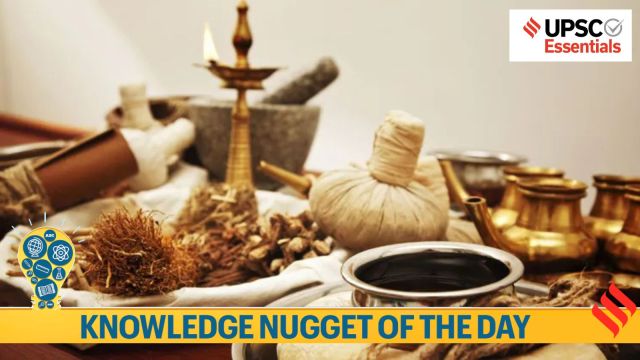
Key Takeaways :
1. Ayurveda is the ancient Indian school of medicine that focuses on holistic well-being. The central government started Ayurveda Day celebrations in 2016 to create more awareness about Ayurveda. The birth anniversary of Dhanvantri was chosen to mark this day, as Dhanvantri is considered the physician of Gods.
2. From this year onward Ayurveda day will be celebrated on 23rd September. The theme of 10th Ayurveda Day is ‘Ayurveda for People, Ayurveda for Planet’, which highlights the enduring legacy of Ayurveda and its contribution to health and ecological sustainability.
3. Ayurveda is seen as one of the most ancient and well-documented systems of medicine, equally relevant in modern times. Its holistic approach, whether for healthy individuals or those with diseases, remains unparalleled.
4. Charaka Samhita by Charaka (based on Agnivesha’s work), Sushruta Samhita by Sushruta, and Ashtanga Hridaya by Vagbhata, Laghu Trayi (three shorter treatises) include Madhava Nidana by Madhavakara, Bhavaprakasha by Bhavamishra, and Sharangadhara Samhita by Sharangadhara are some of the texts related to Ayurveda.
Ancient India’s Contribution to Medicine
1. Charak in his book Charak Samhita had given a description of a large number of diseases and gives methods of identifying their causes as well as the method of their treatment. He was the first who emphasise that digestion, metabolism, and immunity are important for health.
Story continues below this ad
2. The Yoga Sutras of Patanjal has systematically presented the science of Yoga. Yoga developed in ancient India as an allied science of Ayurveda for healing without medicine at the physical and mental levels.
3. Sushruta is often referred to as the “Father of Surgery”. His works have immensely contributed to the field of surgery, especially cosmetic surgery and medical practices within the global community. His work in the book “Sushruta Samhita” reflects his mastery of surgical techniques and human anatomy, marking him as a pioneering figure in the history of medicine.
 Sushruta Science and Technology Heritage of India Gallery – Science Exploration Hall – Science City, Kolkata (Source: Biswarup Ganguly/Wikimedia Commons)
Sushruta Science and Technology Heritage of India Gallery – Science Exploration Hall – Science City, Kolkata (Source: Biswarup Ganguly/Wikimedia Commons)
Government Initiatives to Promote Ayurveda
1. National AYUSH Mission (NAM): It was launched in 2014 to support the promotion and development of AYUSH (Ayurveda, Yoga & Naturopathy, Unani, Siddha, and Homoeopathy) systems in India. It is a Centrally Sponsored Scheme implemented by the Ministry of AYUSH, which was also created on November 9, 2014.
2. AYURGYAN Scheme: It has been approved for the period from FY 2021-2022 to FY 2025-2026 for promoting education and research in the field of Ayush and to support Research & Innovation in Ayush by extramural research and education in Ayush by providing academic activities, training, capacity building, etc. It is a Central Sector Scheme.
Story continues below this ad
3. Ayurswasthya: Under the Centre of Excellence component of AYURSWASTHYA Yojana, financial assistance is provided to eligible individual organisations/institutes for establishing and upgrading their functions & facilities and/or for research & development activities in Ayush. It is a Central Sector Scheme.
4. DRAVYA Portal: Digitised Retrieval Application for Versatile Yardstick of AYUSH Substances (DRAVYA Portal) is the largest collection of data on Ayurvedic ingredients and products made easily available to everyone. It is an ever-growing, ever-evolving database that covers classical Ayurveda textbooks as well as contemporary scientific literature and field studies.
5. APTA Portal: Admirable Personalities to Transform Ayurveda (APTA Portal) is an initiative by the Central Council for Research in Ayurvedic Sciences (CCRAS) under India’s Ministry of AYUSH to document the life and contributions of prominent Ayurveda practitioners and luminaries who have preserved, practised, and promoted Ayurveda.
6. MoU for Global Centre for Traditional Medicine: The Ministry of AYUSH has signed multiple MoUs with WHO for the Global Centre for Traditional Medicine in Gujarat. The ministry has also signed agreements with countries like Germany, Mauritius, Japan, and Nepal for education, research, and recognition of Ayurveda.
Story continues below this ad
7. World Ayurveda Congress: It is a biennial event last held in 2024 at Dehradun, Uttarakhand. The first World Ayurveda Congress was held in 2002 at Kochi as an outreach programme to create greater awareness and opportunities in the practice, science and trade of Ayurveda.
8. Promotion of International Co-operation: The Central Sector Scheme for Promotion of International Co-operation in Ayush aims to promote and strengthen awareness and interest in Ayush Systems of Medicine at the international level. The scheme has specific objectives to facilitate the international promotion, development, and recognition of Ayurveda, Yoga, Naturopathy, Unani, Siddha, Sowa-Rigpa, and Homoeopathy.
9. The Bureau of Indian Standards (BIS) has established a dedicated department for standardisation in the AYUSH sector, publishing 91 standards across areas like Ayurvedic herbs, yoga terminology, Panchakarma equipment, and testing methods. Notably, 80 indigenous standards for traditional herbs support their safe and effective use, while the first national standards for Panchakarma equipment ensure consistency in care.
BEYOND THE NUGGET: Dravyaratnākara Nighaṇṭu and Dravyanamākara Nighaṇṭu
1. The Central Council for Research in Ayurvedic Sciences (CCRAS), under the Ministry of Ayush, has revived two rare and significant Ayurvedic manuscripts—Dravyaratnākara Nighaṇṭu and Dravyanamākara Nighaṇṭu.
2. Dravyaratnākara Nighaṇṭu: Authored by Mudgala Paṇḍita in 1480 AD, this previously unpublished lexicon consists of eighteen chapters offering in-depth knowledge on drug synonyms, therapeutic actions, and medicinal properties.
Story continues below this ad
— A widely referenced text in Maharashtra until the 19th century, it draws from classical Nighaṇṭus like Dhanvantari and Raja Nighaṇṭu while documenting numerous novel medicinal substances from plant, mineral, and animal origins.
3. Dravyanamākara Nighaṇṭu: Attributed to Bhisma Vaidya, this unique work serves as a standalone appendix to the Dhanvantari Nighaṇṭu, focusing exclusively on homonyms of drug and plant names—a complex area of study vital to Ayurveda.
Post Read Question
With reference to Ayurveda, consider the following statements:
1. The theme of 10th Ayurveda Day is ‘Ayurveda for People, Ayurveda for Planet’.
Story continues below this ad
2. Ashtanga Hridaya by Vagbhata, Madhava Nidana by Madhava-kara and Sharangdhar samhita by Sharandhara are some of the texts related to Ayurveda.
Which of the above given statements are true?
(a) 1 only
(b) 2 only
(c) Both 1 and 2
(d) Neither 1 nor 2
(Sources: ayush.gov.in, National Ayurveda Day 2024, Knowledge Nugget: How is Ancient India’s contribution to Science important for UPSC?, pib.gov.in)
Subscribe to our UPSC newsletter. Stay updated with the latest UPSC articles by joining our Telegram channel – Indian Express UPSC Hub, and follow us on Instagram and X.
🚨 Anniversary Special: Read the UPSC Essentials September 2025 special edition, celebrating two years of the magazine! Share your views and suggestions at manas.srivastava@indianexpress.com 🚨



 Sushruta Science and Technology Heritage of India Gallery – Science Exploration Hall – Science City, Kolkata (Source: Biswarup Ganguly/Wikimedia Commons)
Sushruta Science and Technology Heritage of India Gallery – Science Exploration Hall – Science City, Kolkata (Source: Biswarup Ganguly/Wikimedia Commons)






























